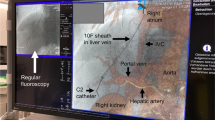Abstract
Purpose.
The aim of our study was to evaluate the radiologist's role in managing paediatric orthotopic liver transplantation (OLT) through a retrospective review of our experience in diagnosing and treating post-OLT complications.
Materials and methods.
Forty children (mean age 4.6 years) underwent 44 OLTs over 71 months. The follow-up period (mean 724 days) was divided into three phases: hospital stay, up to three months after discharge and subsequent period. The number and type of radiological examinations, radiologically detectable complications and interventional procedures were analysed.
Results.
Most examinations were carried out with ultrasound (US) (859/931 of all radiological studies performed during the first two phases, 92.3%). Colour-Doppler US enabled early detection and treatment of all vascular complications (9/40, 22.5% of patients; 13 complications in nine patients, eight arterial and five portal complications; 1.4 for each patient with complications). Computed tomography (CT) or angiography was very rarely employed. US also detected biliary complications (11 patients, 27.5%: three cases of segmental ducts excluded from the anastomosis, four cases of stenosis of the biliodigestive anastomosis, one lithiasis, three stenoses associated with lithiasis), which were successfully managed in 75% of the cases treated with interventional radiology procedures (percutaneous bilioplasty and/or lithotripsy). At the time of writing this paper, the patient survival rate was 100%, and the organ survival rate was 91% (40/44). There were four retransplantations: three due to hepatic artery thrombosis and one to biliary stenosis with lithiasis.
Conclusions.
The radiologist's role is fundamental for early sonographic diagnosis of post-OLT complications in children. Vascular complications are often associated in a single patient, and early treatment may improve the prognosis. Interventional radiology represents a safe and effective treatment for many biliary complications.
Similar content being viewed by others
Author information
Authors and Affiliations
Corresponding author
Rights and permissions
About this article
Cite this article
Sacchetto, P., Veltri, A., Cena, V. et al. The radiologist’s role in managing paediatric liver transplantation: personal experience with 40 patients. Radiol med 112, 456–471 (2007). https://doi.org/10.1007/s11547-007-0128-6
Received:
Accepted:
Published:
Issue Date:
DOI: https://doi.org/10.1007/s11547-007-0128-6




